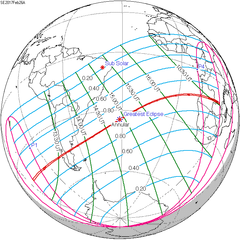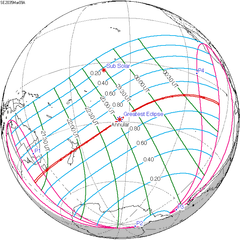| Total eclipse | |||||||||||||||||
 The Moon's hourly motion shown right to left The Moon's hourly motion shown right to left | |||||||||||||||||
| Date | March 3, 2026 | ||||||||||||||||
|---|---|---|---|---|---|---|---|---|---|---|---|---|---|---|---|---|---|
| Gamma | −0.3765 | ||||||||||||||||
| Magnitude | 1.1526 | ||||||||||||||||
| Saros cycle | 133 (27 of 71) | ||||||||||||||||
| Totality | 58 minutes, 19 seconds | ||||||||||||||||
| Partiality | 207 minutes, 10 seconds | ||||||||||||||||
| Penumbral | 338 minutes, 37 seconds | ||||||||||||||||
| |||||||||||||||||
| ← September 2025August 2026 → | |||||||||||||||||
A total lunar eclipse will occur at the Moon’s descending node of orbit on Tuesday, March 3, 2026, with an umbral magnitude of 1.1526. A lunar eclipse occurs when the Moon moves into the Earth's shadow, causing the Moon to be darkened. A total lunar eclipse occurs when the Moon's near side entirely passes into the Earth's umbral shadow. Unlike a solar eclipse, which can only be viewed from a relatively small area of the world, a lunar eclipse may be viewed from anywhere on the night side of Earth. A total lunar eclipse can last up to nearly two hours, while a total solar eclipse lasts only a few minutes at any given place, because the Moon's shadow is smaller. The Moon's apparent diameter will be near the average diameter because it will occur 6.7 days after perigee (on February 24, 2026, at 18:15 UTC) and 6.9 days before apogee (on March 10, 2026, at 9:45 UTC).
This lunar eclipse will be the third of an almost tetrad, with the others being on March 14, 2025 (total); September 8, 2025 (total); and August 28, 2026 (partial).
Visibility
The eclipse will be completely visible over northeast Asia, northwestern North America, and the central Pacific Ocean, seen rising over much of Asia and Australia and setting over North and South America.
 
|
Eclipse details
Shown below is a table displaying details about this particular solar eclipse. It describes various parameters pertaining to this eclipse.
| Parameter | Value |
|---|---|
| Penumbral Magnitude | 2.18580 |
| Umbral Magnitude | 1.15263 |
| Gamma | −0.37651 |
| Sun Right Ascension | 22h56m56.0s |
| Sun Declination | -06°43'06.4" |
| Sun Semi-Diameter | 16'08.0" |
| Sun Equatorial Horizontal Parallax | 08.9" |
| Moon Right Ascension | 10h56m15.0s |
| Moon Declination | +06°24'05.3" |
| Moon Semi-Diameter | 15'37.0" |
| Moon Equatorial Horizontal Parallax | 0°57'18.7" |
| ΔT | 72.1 s |
Eclipse season
See also: Eclipse cycleThis eclipse is part of an eclipse season, a period, roughly every six months, when eclipses occur. Only two (or occasionally three) eclipse seasons occur each year, and each season lasts about 35 days and repeats just short of six months (173 days) later; thus two full eclipse seasons always occur each year. Either two or three eclipses happen each eclipse season. In the sequence below, each eclipse is separated by a fortnight.
| February 17 Ascending node (new moon) |
March 3 Descending node (full moon) |
|---|---|
 |

|
| Annular solar eclipse Solar Saros 121 |
Total lunar eclipse Lunar Saros 133 |
Related eclipses
Eclipses in 2026
- An annular solar eclipse on February 17.
- A total lunar eclipse on March 3.
- A total solar eclipse on August 12.
- A partial lunar eclipse on August 28.
Metonic
- Preceded by: Lunar eclipse of May 16, 2022
- Followed by: Lunar eclipse of December 20, 2029
Tzolkinex
- Preceded by: Lunar eclipse of January 21, 2019
- Followed by: Lunar eclipse of April 14, 2033
Half-Saros
- Preceded by: Solar eclipse of February 26, 2017
- Followed by: Solar eclipse of March 9, 2035
Tritos
- Preceded by: Lunar eclipse of April 4, 2015
- Followed by: Lunar eclipse of January 31, 2037
Lunar Saros 133
- Preceded by: Lunar eclipse of February 21, 2008
- Followed by: Lunar eclipse of March 13, 2044
Inex
- Preceded by: Lunar eclipse of March 24, 1997
- Followed by: Lunar eclipse of February 11, 2055
Triad
- Preceded by: Lunar eclipse of May 3, 1939
- Followed by: Lunar eclipse of January 2, 2113
Lunar eclipses of 2024–2027
This eclipse is a member of a semester series. An eclipse in a semester series of lunar eclipses repeats approximately every 177 days and 4 hours (a semester) at alternating nodes of the Moon's orbit.
The penumbral lunar eclipse on July 18, 2027 occurs in the next lunar year eclipse set.
| Lunar eclipse series sets from 2024 to 2027 | ||||||||
|---|---|---|---|---|---|---|---|---|
| Descending node | Ascending node | |||||||
| Saros | Date Viewing |
Type Chart |
Gamma | Saros | Date Viewing |
Type Chart |
Gamma | |
113
|
2024 Mar 25
|
Penumbral
|
1.0610 | 118
|
2024 Sep 18
|
Partial
|
−0.9792 | |
| 123 | 2025 Mar 14
|
Total
|
0.3485 | 128 | 2025 Sep 07
|
Total
|
−0.2752 | |
| 133 | 2026 Mar 03
|
Total
|
−0.3765 | 138 | 2026 Aug 28
|
Partial
|
0.4964 | |
| 143 | 2027 Feb 20
|
Penumbral
|
−1.0480 | 148 | 2027 Aug 17
|
Penumbral
|
1.2797 | |
Saros 133
This eclipse is a part of Saros series 133, repeating every 18 years, 11 days, and containing 71 events. The series started with a penumbral lunar eclipse on May 13, 1557. It contains partial eclipses from August 7, 1683 through December 17, 1899; total eclipses from December 28, 1917 through August 3, 2278; and a second set of partial eclipses from August 14, 2296 through March 11, 2639. The series ends at member 71 as a penumbral eclipse on June 29, 2819.
The longest duration of totality will be produced by member 35 at 101 minutes, 41 seconds on May 30, 2170. All eclipses in this series occur at the Moon’s descending node of orbit.
| Greatest | First | |||
|---|---|---|---|---|
| The greatest eclipse of the series will occur on 2170 May 30, lasting 101 minutes, 41 seconds. | Penumbral | Partial | Total | Central |
| 1557 May 13 |
1683 Aug 07 |
1917 Dec 28
|
2098 Apr 15
| |
| Last | ||||
| Central | Total | Partial | Penumbral | |
| 2224 Jul 01 |
2278 Aug 03 |
2639 Mar 11 |
2819 Jun 29 | |
Eclipses are tabulated in three columns; every third eclipse in the same column is one exeligmos apart, so they all cast shadows over approximately the same parts of the Earth.
| Series members 15–36 occur between 1801 and 2200: | |||||
|---|---|---|---|---|---|
| 15 | 16 | 17 | |||
| 1809 Oct 23 | 1827 Nov 03 | 1845 Nov 14 | |||
| 18 | 19 | 20 | |||
| 1863 Nov 25 | 1881 Dec 05 | 1899 Dec 17 | |||
| 21 | 22 | 23 | |||
| 1917 Dec 28 | 1936 Jan 08 | 1954 Jan 19 | |||

|

|

|

|

|

|
| 24 | 25 | 26 | |||
| 1972 Jan 30 | 1990 Feb 09 | 2008 Feb 21 | |||

|

|

|

|

|

|
| 27 | 28 | 29 | |||
| 2026 Mar 03 | 2044 Mar 13 | 2062 Mar 25 | |||

|

|

|

|
||
| 30 | 31 | 32 | |||
| 2080 Apr 04 | 2098 Apr 15 | 2116 Apr 27 | |||

|

|

|

|
||
| 33 | 34 | 35 | |||
| 2134 May 08 | 2152 May 18 | 2170 May 30 | |||
| 36 | |||||
| 2188 Jun 09 | |||||
Metonic series
The Metonic cycle repeats nearly exactly every 19 years and represents a Saros cycle plus one lunar year. Because it occurs on the same calendar date, the Earth's shadow will be in nearly the same location relative to the background stars.
|
|

|

|
Inex series
The inex series repeats eclipses 20 days short of 29 years, repeating on average every 10571.95 days. This period is equal to 358 lunations (synodic months) and 388.5 draconic months. Saros series increment by one on successive Inex events and repeat at alternate ascending and descending lunar nodes.
This period is 383.6734 anomalistic months (the period of the Moon's elliptical orbital precession). Despite the average 0.05 time-of-day shift between subsequent events, the variation of the Moon in its elliptical orbit at each event causes the actual eclipse time to vary significantly. It is a part of Lunar Inex series 35.
| Descending node | Ascending node | Descending node | Ascending node | ||||
|---|---|---|---|---|---|---|---|
| Saros | Date Chart |
Saros | Date Chart |
Saros | Date Chart |
Saros | Date Chart |
| 115 | 1505 Feb 18
|
116 | 1534 Jan 30
|
117 | 1563 Jan 9 | 118 | 1591 Dec 30 |
| 119 | 1620 Dec 9 | 120 | 1649 Nov 19 | 121 | 1678 Oct 29 | 122 | 1707 Oct 11 |
| 123 | 1736 Sep 20 | 124 | 1765 Aug 30 | 125 | 1794 Aug 11 | 126 | 1823 Jul 23 |
| 127 | 1852 Jul 1 | 128 | 1881 Jun 12 | 129 | 1910 May 24
|
130 | 1939 May 3
|
| 131 | 1968 Apr 13
|
132 | 1997 Mar 24
|
133 | 2026 Mar 3
|
134 | 2055 Feb 11
|
| 135 | 2084 Jan 22
|
136 | 2113 Jan 2 | 137 | 2141 Dec 13 | 138 | 2170 Nov 23 |
| 139 | 2199 Nov 2 | 140 | 2228 Oct 14 | 141 | 2257 Sep 24 | 142 | 2286 Sep 3 |
| 143 | 2315 Aug 16 | 144 | 2344 Jul 26 | 145 | 2373 Jul 5 | 146 | 2402 Jun 16 |
| 147 | 2431 May 27 | 148 | 2460 May 5
|
149 | 2489 Apr 16
| ||
Half-Saros cycle
A lunar eclipse will be preceded and followed by solar eclipses by 9 years and 5.5 days (a half saros). This lunar eclipse is related to two annular solar eclipses of Solar Saros 140.
| February 26, 2017 | March 9, 2035 |
|---|---|

|

|
See also
References
- "March 2–3, 2026 Total Lunar Eclipse (Blood Moon)". timeanddate. Retrieved 19 November 2024.
- "Moon Distances for London, United Kingdom, England". timeanddate. Retrieved 19 November 2024.
- "Total Lunar Eclipse of 2026 Mar 03" (PDF). NASA. Retrieved 19 November 2024.
- "Total Lunar Eclipse of 2026 Mar 03". EclipseWise.com. Retrieved 19 November 2024.
- van Gent, R.H. "Solar- and Lunar-Eclipse Predictions from Antiquity to the Present". A Catalogue of Eclipse Cycles. Utrecht University. Retrieved 6 October 2018.
- "NASA - Catalog of Lunar Eclipses of Saros 133". eclipse.gsfc.nasa.gov.
- Listing of Eclipses of series 133
- Mathematical Astronomy Morsels, Jean Meeus, p.110, Chapter 18, The half-saros
External links
- Saros cycle 133
- 2026 Mar 03 chart: Eclipse Predictions by Fred Espenak, NASA/GSFC


